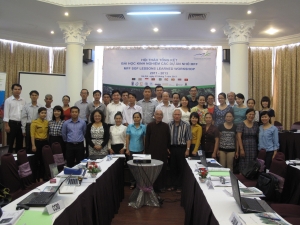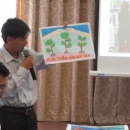Stories of conflicts: a review of MFF Small Grant Projects 2011-2013
Location: Hanoi, Viet Nam. 23rd Jul 2013
Projects struggled with three kinds of conflict: economic vs. environmental, individual vs. community, and new vs. traditional.
Most conservation projects have to deal with the first kind of conflict because almost by definition conservation means delaying consumption in the short term even if it means greater benefits in the long term. The projects addressed this conflict in different ways. Xuan Thuy National Park negotiated a benefit sharing agreement with hundreds women that legalizes and regulates their access to the park’s core zone to collect clams and other high-value aquatic products. Grantees in Lang Co, Thua Thien Hue and An Hoa Lagoon, Quang Nam supported shrimp, crab, and fish production under a mangrove canopy that may be less profitable in the short term but offers lower risk, greater diversity, and increased resilience in the long term.
Inevitably, things are more complicated than they first appear.
Mui Ca Mau National Park paid a local person VND300,000/month to join community-led patrols to stop illegal mangrove cutting to make charcoal. But given the high profits from charcoal production, this payment has proved insufficient to stop him continuing to cut mangroves. Moreover, when the MFF grant terminates, the park will have to finance these patrols from its own resources (which it has promised to do). Another option is to provide low interest loans from the Vietnam Bank for Social Policy to charcoal makes to invest in new livelihoods. In Lang Co, the mangroves have been allocated to the local community but not the land, which is under the control of the Chan May Lang Co Economic Zone, which at the start of the project planned to convert the mangrove forest into a golf course.
The second kind of conflict is illustrated by the story of Nguyen Xuan Vinh, a restaurant owner who planted two hectares of mangroves in Lang Co. But who do these belong to? Since the mangroves are allocated to the village, can other families access Vinh’s mangroves? Does Vinh, a relatively wealthy man, have an obligation to the village? If not, conflict could ensure. According to the Center for Community Research and Development (CCRD), the grantee, Vinh has agreed to return the mangroves to the village to manage after five years. CCRD promised to monitor this agreement.
A story from An Hoa Lagoon showed how local authorities are scared of touching sensitive land issues. Nguyen Thi Nguyet, head of the women’s mangrove conservation club, said that although families inherit mangroves area from their parents, the land is still under local government management. The Commune People’s Committee was therefore very hesitant to allow 10 families to establish crab banks in the mangroves because they wanted to check that the mangroves were not under dispute among households. As a result, the crab bank was delayed and later failed because the crab seeds were dispersed in April when the water temperature was too high for the seeds to survive.
The third kind of conflict was highlighted by the Quang Tri Center for Environmental Monitoring and Technology in Gio Linh District. The small grant project built on a Sida-funded project that tried to reduce solid waste pollution by establishing a landfill in one village where people from surrounding villages could dump their trash and by arranging for garbage trucks to take household waste to the landfill. However, almost all the villagers are fishermen who believe that bringing trash from other villages brings bad luck. As a result, rather than establish a central landfill, MFF financed the installation of trash cans in the target village and arranged for the Commune People’s Committee to contract with an urban company to collect waste every 10 days. Each local household pays VND10,000/month to the company.
These examples show how what doesn’t work is just as interesting and important as what does and the need to ensure that grantees and beneficiaries can meet in a relaxed environment to share project successes and failures.
Ms. Le Thi Thanh Thuy - Programme Assistant - IUCN Viet Nam


